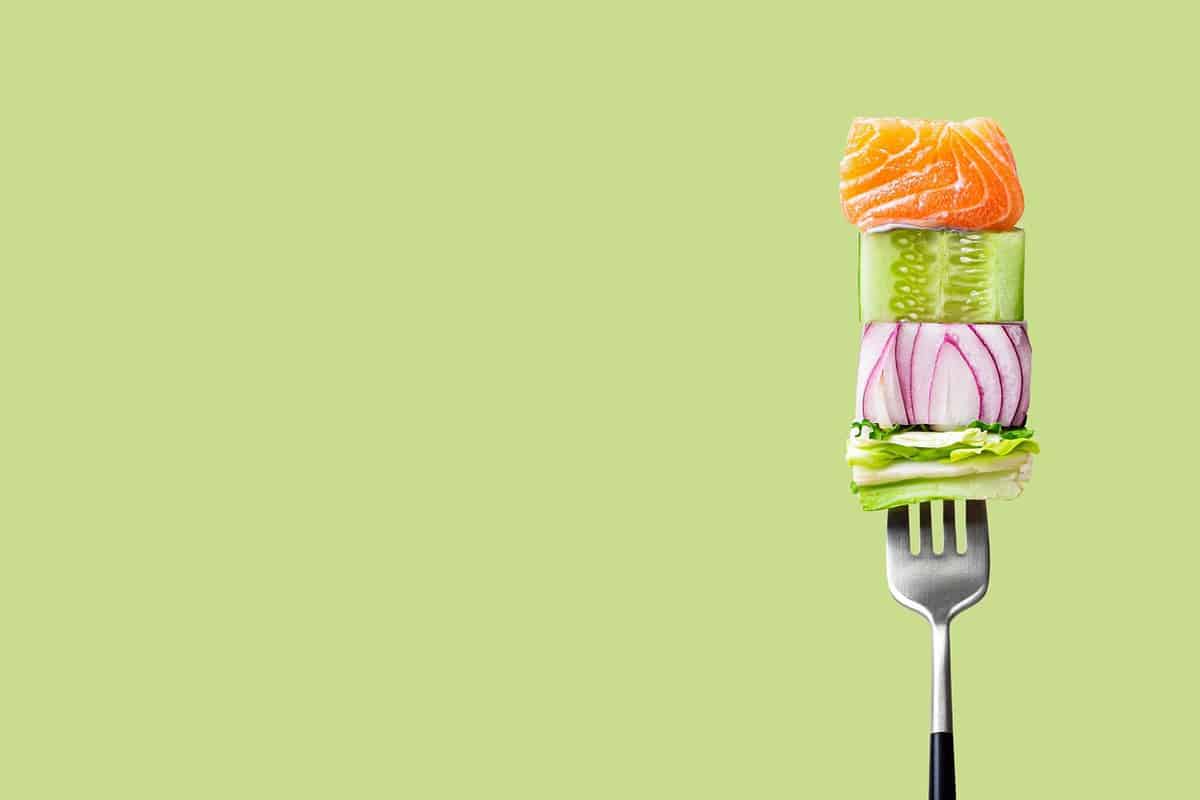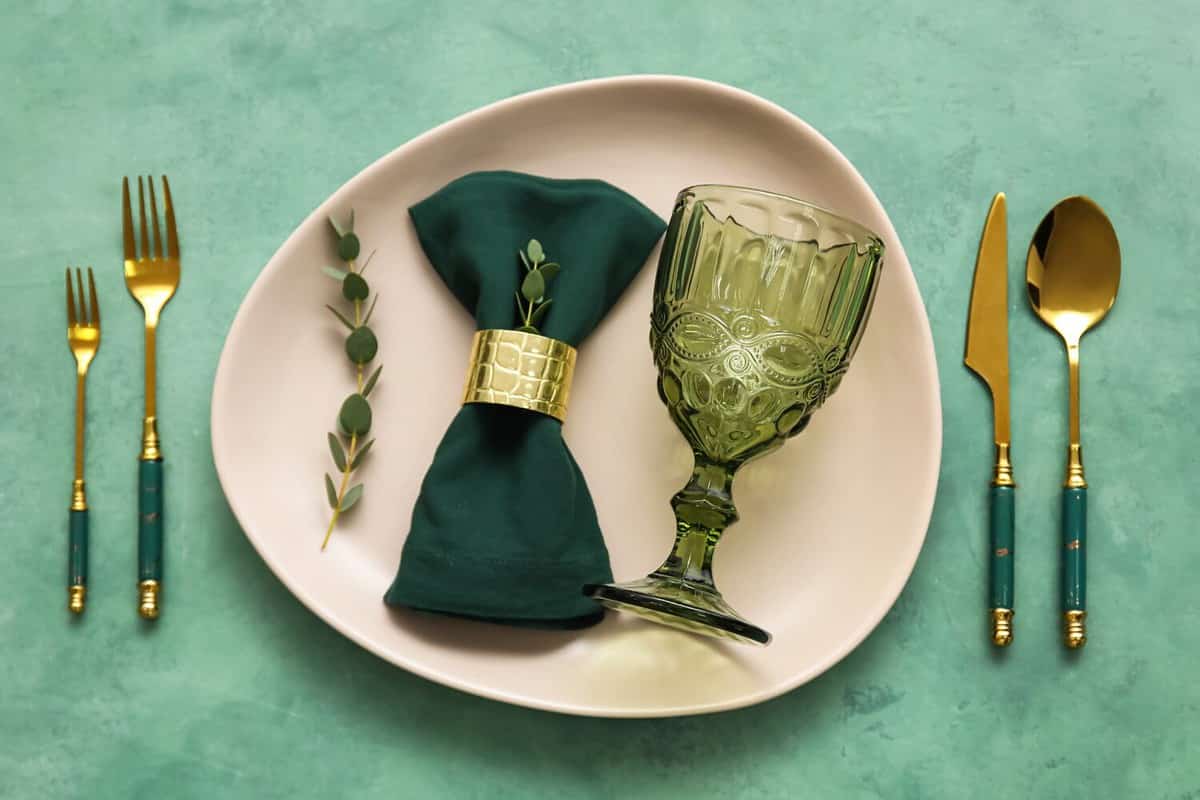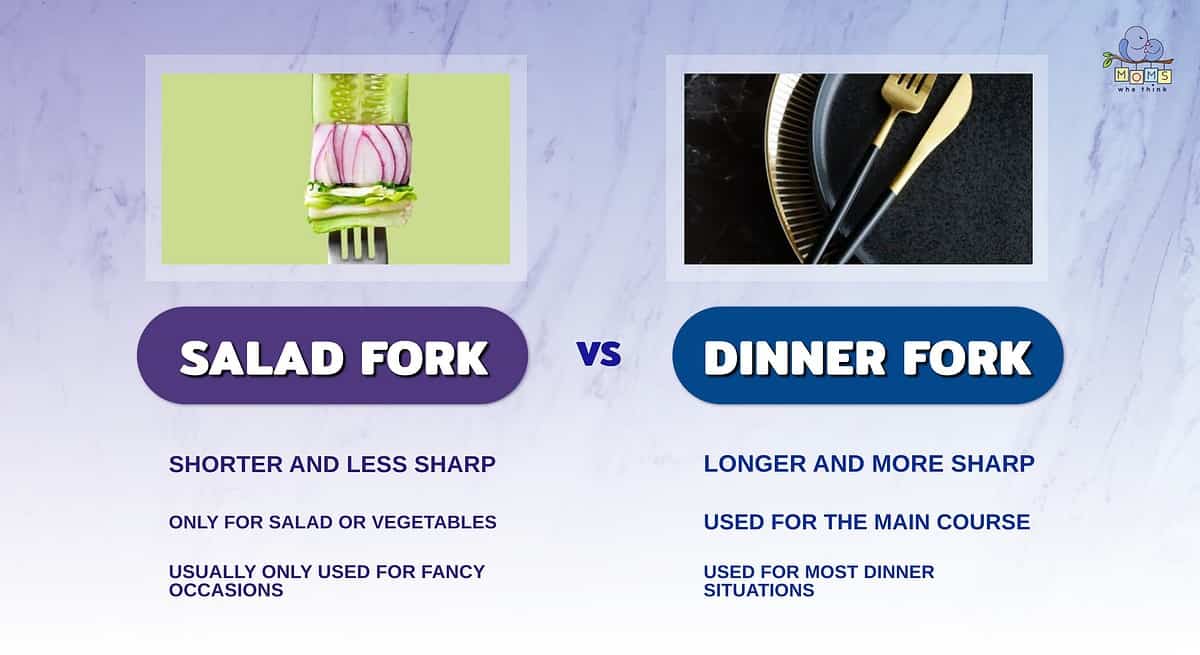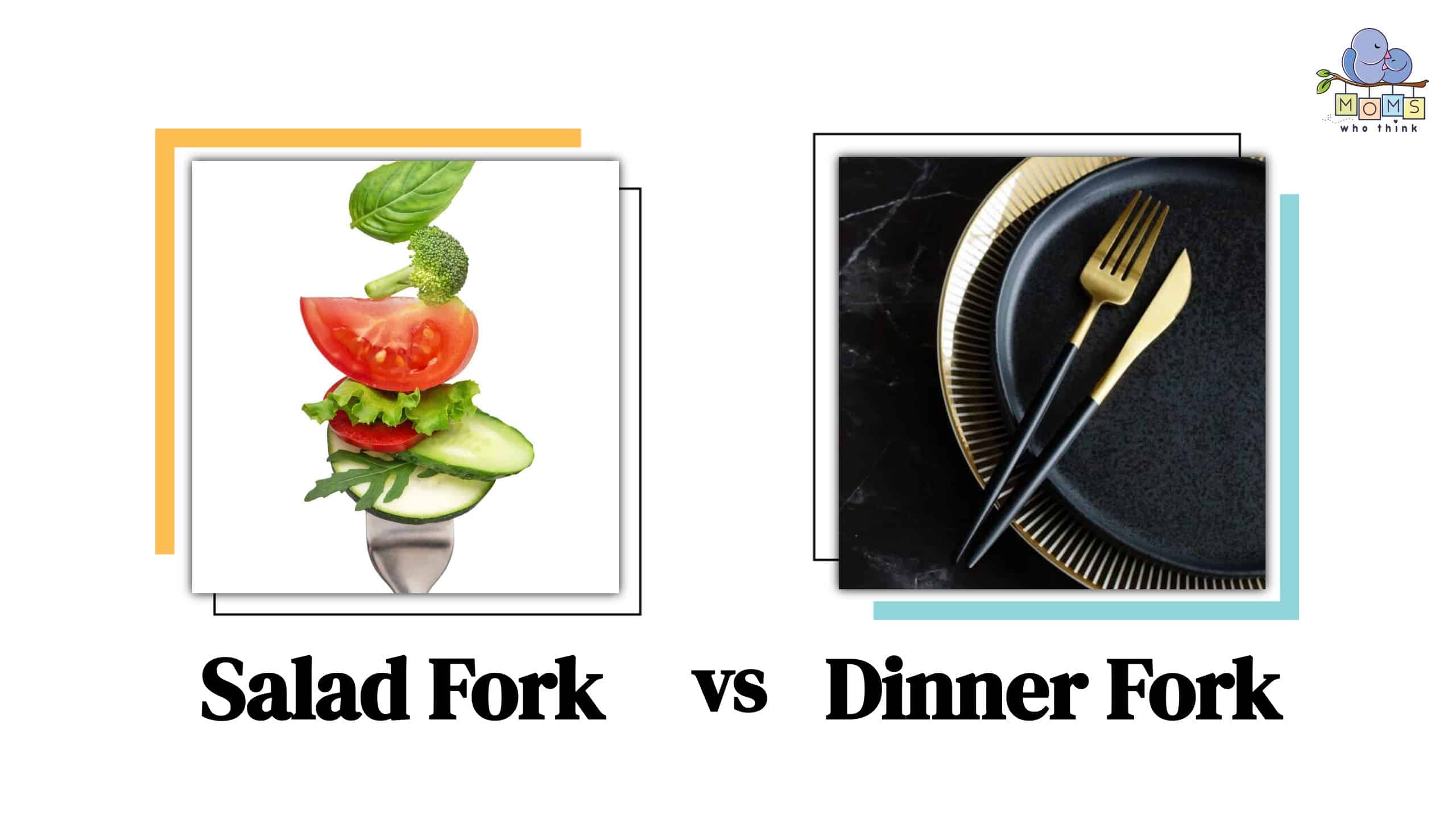Imagine you’re attending a dinner party or eating at an expensive restaurant. When the first course is served, you reach for a fork and realize there’s more silverware next to your plate than you’re used to. To avoid using the wrong one, you quickly search for the difference between a salad fork vs dinner fork.
The main difference between a salad fork and a dinner fork is the size and shape of the fork. A salad fork is specifically for salad or vegetables, so it’s shorter and less sharp than a dinner fork. The dinner fork is for the main course so it’s longer and sharper. The order they’re in will depend on whether the salad or main course is served first.
If you’re headed to a fancy dinner or party and need to know the proper etiquette for silverware usage, we’ve got you covered. Keep reading to find out the difference between a salad fork vs dinner fork and when to use each.

The salad fork is a small fork for eating salads, vegetables, and other appetizers.
©Elena Eryomenko/Shutterstock.com
Salad Fork vs Dinner Fork: What Is the Difference?
Most of us aren’t used to using more than one fork for our meals. However, if you ever attend a dinner party or eat in an expensive restaurant, you may be presented with multiple forks, spoons, and other silverware.
Two of the most common types of silverware in a complete set are salad forks and dinner forks. Even though they may look similar, they’re designed for different parts of the meal. Much like it sounds, a salad fork is used for eating salad. It can also be used for another small plate like a vegetable appetizer or small dessert.
The main difference between a salad fork and a dinner fork is the size. Generally, the salad fork will be one size smaller than the dinner fork. The tips of the salad fork are also different from the dinner fork. While the tips of the salad fork are sharp enough to grab lettuce or vegetables, they’re also rounder than the dinner fork since they’re for salad or vegetables, not meat..
What is a Salad Fork?
A salad fork, true to its name, is the fork used to eat the salad before a meal. If you’re looking down at your dinner plate and need a quick way to identify the salad fork, the salad fork will generally be the smallest out of all the forks. It will also likely be the one farthest to the left.
The salad fork is specifically designed to be used with salad or vegetables. It’s generally placed all the way to the left, however, there may be a different placement if the salad is served at a different time.
The salad fork will usually have four tines but it can have as few as three. Additionally, the tine farthest to the left is often wider for cutting parts of the salad or vegetables. Sometimes, you may notice that it doesn’t have this distinction and it will instead just be a smaller fork with a knife to go along with it.
The size may vary depending on which type of salad fork it is, but you know it will be smaller than the dinner fork. If there’s only one fork next to your plate, you don’t have to worry about the distinction. However, if there are multiple forks, choose the smallest one to begin your meal.
When Were Salad Forks Created?
Salad forks aren’t something we see as often nowadays. The history of salad forks may go back to the 1700s when table settings included a variety of silverware. The traditional table setting around that time usually included a salad fork, dinner fork, knife, soup spoon, and teaspoon.
Although people have been using some kind of tools to eat with for as long as humans have been around, flatware has certainly evolved over time. The silverware we associate with meals today didn’t become popular until the late 1800s and early 1900s.

The dinner fork is larger and sharper than the salad fork since you use it for the main course.
©Pixel-Shot/Shutterstock.com
What is a Dinner Fork?
Once you’ve identified which fork is the salad fork, you’ll notice a larger fork at your place setting as well. The dinner fork is the larger fork for the main course of dinner. Compared to the salad fork, it will be longer and may have an additional tine. However, in most cases, the standard dinner fork will have four tines that are equal in size.
Along with the salad fork, you’ll find the dinner fork on the left side of your plate. The dinner fork may be on the left or right of any other silverware, and the order will depend on the type of courses served with the meal.
This fork will also have a knife on the right side of the plate to go along with it so you can properly cut your meal. The dinner fork is the most common name for this piece of silverware, but some might call it the place fork instead.
Can You Substitute a Salad Fork for a Dinner Fork?
Considering the differences between the various pieces of silverware next to your plate, you might wonder if you can use them interchangeably. Unless you’re visiting an expensive restaurant or fancy dinner party, you’ll most likely find only one basic set of silverware. In this case, you’ll only have one fork that you’ll use for the salad, side dish, and main course.
However, if you do attend a dinner party, you might notice there are extra pieces of silverware for you to use. Although you technically could use the dinner fork for the salad and vice versa, it wouldn’t be proper etiquette.
Not only are there specific rules that you’re expected to follow at a dinner party or fancy restaurant, but the proper forks are also designed for certain parts of the meal. If you’re at home or at a casual-get together with friends, in that case, you can feel free to use whichever fork you have on hand.
Which Fork Do You Use First?
While most people may think of eating a salad before your main course, this may not always be the case. If you’re not sure which fork to use first or you forget once you get to the dinner party, the general rule is to start with the utensil all the way to the left.
Generally, the location of the salad fork is specifically based on the courses for that dinner. If the salad comes before the main course, the salad fork should be to the left of the dinner fork. If the salad is served after, the dinner fork should be on the left. When in doubt, choose the fork that is first in line at your table setting.
Final Thoughts

- A salad fork is shorter and less sharp than a dinner fork. Since you won't be using a salad fork for meat, there isn't a need for it to be on the sharper side.
- If you have a salad fork, it should only be used for salad or vegetables. Switch to the dinner fork when the main course is served.
- A lot of times, you'll only have one fork at a dinner. If you're at a dinner party or fancy restaurant, however, you may find a salad fork on the table. Always use the fork that's the furthest to the left!
Most of us typically use only one fork for our whole meal and we don't generally eat four or five-course meals. However, if you’re going to a fancy restaurant or dinner party, it’s important to know proper dining etiquette.
Part of dining etiquette is knowing the purpose of each piece of silverware, especially when it comes to the salad fork vs dinner fork. The salad fork is a smaller fork you'll use for the salad or vegetables.
It’s a size smaller than the dinner fork, which is for your main course. Generally, the salad will come before the main course. When in doubt, use the fork furthest to the left for the salad or appetizer. Dining etiquette may seem like a thing of the past, but if you attend a dinner party or other event, you'll be glad to know the difference between a salad fork vs dinner fork.
Salad Recipes
Dinner Recipes
- Healthy Pork Dinner Recipes
- Easy Family Dinner Recipes
- Healthy Ideas for Dinner
- Chicken Green Bean and Rice Skillet Dinner
- Healthy Meatless and Seafood Dinner Recipes

Cobb Salad
Ingredients
Salad Ingredients:
- 1/2 head iceberg lettuce
- 1/2 bunch watercress
- 1 small bunch of curly endive
- 1/2 head romaine lettuce
- 2 Tablespoons chives, minced
- 2 medium tomatoes, peeled, seeded, diced
- 1 whole boneless skinless chicken breast, cooked and diced
- 6 bacon slices, cooked and diced
- 1 avocado, peeled and diced
- 3 hard-boiled eggs, diced
- 1/2 cup Roquefort cheese, crumbled
French Dressing Ingredients:
- 1/4 cup water
- 1/4 cup red wine vinegar
- 1/4 teaspoon sugar
- 1 1/2 teaspoons lemon juice
- 1/2 teaspoon salt
- 1/2 teaspoon black pepper
- 1/2 teaspoon Worcestershire sauce
- 3/4 teaspoon dry mustard
- 1/2 garlic clove, minced
- 1/4 cup olive oil
- 3/4 cup vegetable oil
Instructions
- Chop lettuce, watercress, endive, and romaine into very fine pieces. Mix in 1 large wide bowl or 6 individual wide shallow bowls. Add chives.
- Arrange tomatoes, chicken, bacon, avocado, and eggs in narrow strips or wedges across the top of the greens. Sprinkle with cheese. Chill.
- Meanwhile, to make the dressing, combine water, vinegar, sugar, lemon juice, salt, pepper, Worcestershire, mustard, garlic, and oils. Chill.
- At serving time, shake the dressing well. At the table, pour 1/2 cup of dressing over the salad and toss. Pass the remaining dressing at the table.


